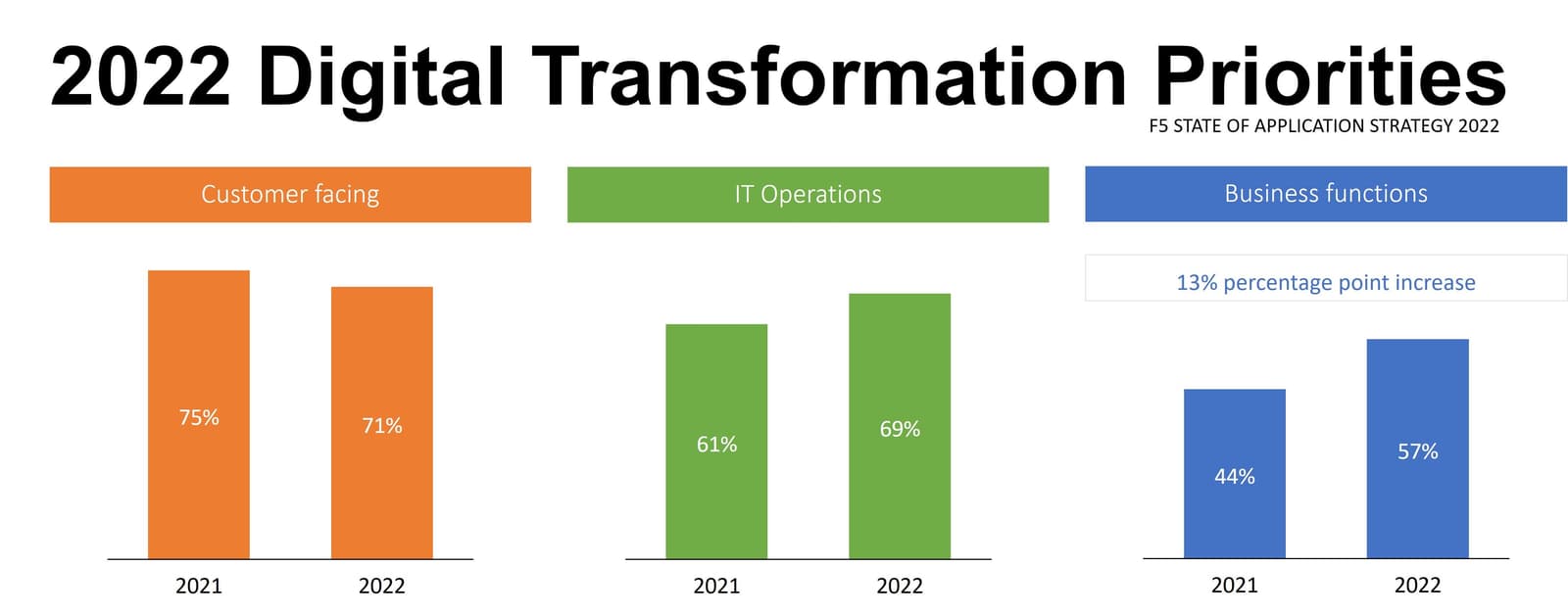The focus of digital transformation is shifting to the hidden (back-office) functions needed to fully digitize the customer experience. HR and finance functions are both seeing increasing focus over previous years and legal functions are getting even more much-needed attention.

Customer-facing functions are still a priority, but we’re seeing IT operations and business functions becoming more of a focus. That’s unsurprising as COVID drove the rapid digitization of all aspects of life and forced organizations to go “all in” on customer experience.
But what we see now is organizations running into roadblocks on their digital transformation journey. They’ve digitized the external customer experience but haven’t put a lot of work into the plethora of internal functions needed to support that experience.
Inserting manual, paper-based steps into the middle of an automated, digital experience slows it down and introduces the potential for human error. So they’ve begun focusing on digitizing internal tasks via applications. This focus impacts every area of business. Nineteen percent of organizations are digitizing legal functions. If that seems strange, consider that legal concerns touch many aspects of customer-facing business such as agreements, contracts, subscriptions, purchases, and refunds as well as internal capabilities with respect to hiring, procurement, on-boarding vendors, and managing patent portfolios. This is one of the reasons we see an increase in organizations participating in phase one; they have “started over” with line of business functions that remain manual and paper-based.
Why Legal Business Functions are Critical for Success
Healthcare has gone digital. According to the College of Healthcare Information Management Executives “Most Wired” survey, in 2021 “usage and adoption of telehealth continued to increase on the whole, but the growth curve stabilized from the sharper curve of 2020. Reported usage (measured by percentage of patients who used telehealth at each facility) has more than doubled since 2019.” And BDO, in its 2021 Healthcare Digital Transformation Survey found that 75% invested in telemedicine, 64% in HER interoperability, and 56% on patient portals.
Those patient portals are great, but many are still lacking digital support for legal and regulatory functions. These web and mobile apps offer a mostly digital experience but can run into both HIPAA and COPPA obstacles. For example, I was able to sign up and receive my COVID test results through such a patient portal in a matter of minutes. But to get the results for my teenage son I had to call a nurse. That’s because the process to authorize parent proxy access to digital records requires the completion of a paper form, signed by the minor, and physically mailed to the healthcare provider. One assumes from there it is scanned, stored, and associated with the relevant permissions on the records.
Needless to say, the process would take days—if not weeks—when I needed those results in hours.
This is why the results of our own annual survey were so exciting, and why a shifting of digital transformation priorities toward business functions like legal should excite you too. Even digitizing every step in a process but one will lead to failure at worst and frustration at best. It’s like driving a car cross-country and stopped to walk across one state instead. If that sounds ridiculous, then you see why effectively replicating that inefficiency in a digital workflow is just as unfathomable.
Every business function that touches, in any way, the customer experience must be fully digitized to successfully deliver an extraordinary digital experience. That means legal functions are just as critical as web front ends and mobile apps.
This finding is but one of the many exciting and sometimes surprising results we uncovered during the analysis of our annual research. I look forward to sharing those discoveries and insights with you when we publish the State of Application Strategy 2022 in March.
If you can’t wait, the incredible Cindy Borovick and I will be offering a sneak peek into the results at our annual conference, Agility, in February. It’s free and virtual and you’ll be the first to hear our surprising insights before anyone else.
And as always, watch this space for forthcoming blogs with data and analysis you won’t find in the official report.
About the Author

Related Blog Posts

Multicloud chaos ends at the Equinix Edge with F5 Distributed Cloud CE
Simplify multicloud security with Equinix and F5 Distributed Cloud CE. Centralize your perimeter, reduce costs, and enhance performance with edge-driven WAAP.
At the Intersection of Operational Data and Generative AI
Help your organization understand the impact of generative AI (GenAI) on its operational data practices, and learn how to better align GenAI technology adoption timelines with existing budgets, practices, and cultures.
Using AI for IT Automation Security
Learn how artificial intelligence and machine learning aid in mitigating cybersecurity threats to your IT automation processes.
Most Exciting Tech Trend in 2022: IT/OT Convergence
The line between operation and digital systems continues to blur as homes and businesses increase their reliance on connected devices, accelerating the convergence of IT and OT. While this trend of integration brings excitement, it also presents its own challenges and concerns to be considered.
Adaptive Applications are Data-Driven
There's a big difference between knowing something's wrong and knowing what to do about it. Only after monitoring the right elements can we discern the health of a user experience, deriving from the analysis of those measurements the relationships and patterns that can be inferred. Ultimately, the automation that will give rise to truly adaptive applications is based on measurements and our understanding of them.
Inserting App Services into Shifting App Architectures
Application architectures have evolved several times since the early days of computing, and it is no longer optimal to rely solely on a single, known data path to insert application services. Furthermore, because many of the emerging data paths are not as suitable for a proxy-based platform, we must look to the other potential points of insertion possible to scale and secure modern applications.
